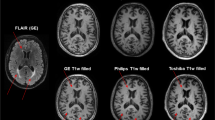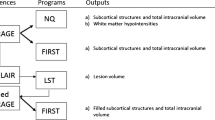Abstract
Fast, reliable and easy-to-use methods to quantify brain atrophy are of increasing importance in clinical studies on neuro-degenerative diseases. Here, ILAB 4, a new volumetry software that uses a fast semi-automated 3D segmentation of thin-slice T1-weighted 3D MR images based on a modified watershed transform and an automatic histogram analysis was evaluated. It provides the cerebral volumes: whole brain, white matter, gray matter and intracranial cavity. Inter- and intra-rater reliability and scan-rescan reproducibility were excellent in measuring whole brain volumes (coefficients of variation below 0.5%) of volunteers and patients. However, gray and white matter volumes were more susceptible to image quality. High accuracy of the absolute volume results (±5 ml) were shown by phantom and preparation measurements. Analysis times were 6 min for processing of 128 slices. The proposed technique is reliable and highly suitable for quantitative studies of brain atrophy, e.g., in multiple sclerosis.





Similar content being viewed by others
Notes
ILAB4 has been developed in C++ and runs on standard PC hardware (PIII 1GHz, 512 MB RAM) under Microsoft Windows. However, its successor MeVisLAB, will be available for both Windows and Linux. If you are interested in using ILAB and/or the brain volumetry package within a scientific collaboration, please contact MeVis at: Fax. +49-421-2184236, e-mail: ilab4@mevis.de.
References
Rovaris M, Filippi M (1999) Magnetic resonance techniques to monitor disease evolution and treatment trial outcomes in multiple sclerosis. Curr Opin Neurol 12:337–344
Rovaris M, Comi G, Rocca MA, Wolinsky JS, Filippi M (2001) Short-term brain volume change in relapsing-remitting multiple sclerosis: effect of glatiramer acetate and implications. Brain 124:1803–1812
Stevenson VL, Leary SM, Losseff NA, Parker GJ, Barker GJ, Husmani Y, Miller DH, Thompson AJ (1998) Spinal cord atrophy and disability in MS: a longitudinal study. Neurology 51:234–238
Rudick RA, Fisher E, Lee JC, Simon J, Jacobs L (1999) Use of the brain parenchymal fraction to measure whole brain atrophy in relapsing-remitting MS: multiple sclerosis collaborative research group. Neurology 53:1698–1704
Losseff NA, Wang L, Lai HM, Yoo DS, Gawne-Cain ML, McDonald WI, Miller DH, Thompson AJ (1996) Progressive cerebral atrophy in multiple sclerosis: a serial MRI study. Brain 119:2009–2019
Losseff NA, Webb SL, O’Riordan JI, Page R, Wang L, Barker GJ, Tofts PS, McDonald WI, Miller DH, Thompson AJ (1996) Spinal cord atrophy and disability in multiple sclerosis: a new reproducible and sensitive MRI method with potential to monitor disease progression. Brain 119:701–708
Phillips MD, Grossman RI, Miki Y, Wei L, Kolson DL, van Buchem MA, Polansky M, McGowan JC, Udupa JK (1998) Comparison of T2 lesion volume and magnetization transfer ratio histogram analysis and of atrophy and measures of lesion burden in patients with multiple sclerosis. AJNR Am J Neuroradiol 19:1055–1060
Edwards SG, Gong QY, Liu C, Zvartau ME, Jaspan T, Roberts N, Blumhardt LD (1999) Infratentorial atrophy on magnetic resonance imaging and disability in multiple sclerosis. Brain 122:291–301
Trapp BD, Peterson J, Ransohoff RM, Rudick R, Mork S, Bo L (1998) Axonal transection in the lesions of multiple sclerosis. N Engl J Med 338:278–285
Lassmann H, Raine CS, Antel J, Prineas JW (1998) Immunopathology of multiple sclerosis: report on an international meeting held at the Institute of Neurology of the University of Vienna. J Neuroimmunol 86:213–217
Silver NC, Barker GJ, Losseff NA, Gawne-Cain ML, MacManus DG, Thompson AJ, Miller DH (1997) Magnetisation transfer ratio measurement in the cervical spinal cord: a preliminary study in multiple sclerosis. Neuroradiology 39:441–445
Silber E, Sharief MK (1999) Axonal degeneration in the pathogenesis of multiple sclerosis. J Neurol Sci 170:11–18
Rovaris M, Filippi M, Calori G, Rodegher M, Campi A, Colombo B, Comi G (1997) Intra-observer reproducibility in measuring new putative MR markers of demyelination and axonal loss in multiple sclerosis: a comparison with conventional T2-weighted images. J Neurol 244:266–270
Matthews PM (1999) Axonal loss and demyelation in multiple sclerosis. J Neurol Neurosurg Psychiatry 67:708–709
Lin X, Blumhardt LD (2001) Inflammation and atrophy in multiple sclerosis: MRI associations with disease course. J Neurol Sci 189:99–104
Simon JH, Jacobs LD, Campion MK, Rudick RA, Cookfair DL, Herndon RM, Richert JR, Salazar AM, Fischer JS, Goodkin DE, Simonian N, Lajaunie M, Miller DE, Wende K, Martens-Davidson A, Kinkel RP, Munschauer FE III, Brownscheidle CM (1999) A longitudinal study of brain atrophy in relapsing multiple sclerosis: the multiple sclerosis collaborative research group (MSCRG). Neurology 53:139–148
Nijeholt GJ, van Walderveen MA, Castelijns JA, van Waesberghe JH, Polman C, Scheltens P, Rosier PF, Jongen PJ, Barkhof F (1998) Brain and spinal cord abnormalities in multiple sclerosis: correlation between MRI parameters, clinical subtypes and symptoms. Brain 121:687–697
Lycklama A, Nijeholt GJ, Barkhof F, Scheltens P, Castelijns JA, Ader H, van Waesberghe JH, Polman C, Jongen SJ, Valk J (1997) MR of the spinal cord in multiple sclerosis: relation to clinical subtype and disability. AJNR Am J Neuroradiol 18:1041–1048
Dastidar P, Heinonen T, Lehtimaki T, Ukkonen M, Peltola J, Erila T, Laasonen E, Elovaara I (1999) Volumes of brain atrophy and plaques correlated with neurological disability in secondary progressive multiple sclerosis. J Neurol Sci 165:36–42
Liu C, Edwards S, Gong Q, Roberts N, Blumhardt LD (1999) Three dimensional MRI estimates of brain and spinal cord atrophy in multiple sclerosis. J Neurol Neurosurg Psychiatry 66:323–330
Leist TP, Gobbini MI, Frank JA, McFarland HF (2001) Enhancing magnetic resonance imaging lesions and cerebral atrophy in patients with relapsing multiple sclerosis. Arch Neurol 58:57–60
Ge Y, Grossman RI, Udupa JK, Babb JS, Nyul LG, Kolson DL (2001) Brain atrophy in relapsing-remitting multiple sclerosis: fractional volumetric analysis of gray matter and white matter. Radiology 220:606–610
Chard DT, Griffin CM, Parker GJ, Kapoor R, Thompson AJ, Miller DH (2002) Brain atrophy in clinically early relapsing-remitting multiple sclerosis. Brain 125:327–337
De Stefano N, Matthews PM, Filippi M, Agosta F, De Luca M, Bartolozzi ML, Guidi L, Ghezzi A, Montanari E, Cifelli A, Federico A, Smith SM (2003) Evidence of early cortical atrophy in MS: relevance to white matter changes and disability. Neurology 60:1157–1162
Quarantelli M, Ciarmiello A, Morra VB, Orefice G, Larobina M, Lanzillo R, Schiavone V, Salvatore E, Alfano B, Brunetti A (2003) Brain tissue volume changes in relapsing-remitting multiple sclerosis: correlation with lesion load. Neuroimage 18:360–366
Miller DH, Barkhof F, Frank JA, Parker GJ, Thompson AJ (2002) Measurement of atrophy in multiple sclerosis: pathological basis, methodological aspects and clinical relevance. Brain 125:1676–1695
Ge Y, Grossman RI, Babb JS, Rabin ML, Mannon LJ, Kolson DL (2002) Age-related total gray matter and white matter changes in normal adult brain. Part I: volumetric MR imaging analysis. AJNR Am J Neuroradiol 23:1327–33
Courchesne E, Chisum HJ, Townsend J, Cowles A, Covington J, Egaas B, Harwood M, Hinds S, Press GA (2000) Normal brain development and aging: quantitative analysis at in vivo MR imaging in healthy volunteers. Radiology 216:672–682
Matthews PM, Pioro E, Narayanan S, De Stefano N, Fu L, Francis G, Antel J, Wolfson C, Arnold DL (1996) Assessment of lesion pathology in multiple sclerosis using quantitative MRI morphometry and magnetic resonance spectroscopy. Brain 119:715–722
Alfano B, Quarantelli M, Brunetti A, Larobina M, Covelli EM, Tedeschi E, Salvatore M (1998) Reproducibility of intracranial volume measurement by unsupervised multispectral brain segmentation. Magn Reson Med 39:497–499
Filippi M, Mastronardo G, Rocca MA, Pereira C, Comi G (1998) Quantitative volumetric analysis of brain magnetic resonance imaging from patients with multiple sclerosis. J Neurol Sci 158:148–153
Hahn HK, Peitgen HO, Link F (2003) Concepts for rapid application prototyping in medical image analysis and visualization. In: Proceedings of Simulation und Visualising. SCS, Erlangen, pp 283–298
Hahn HK, Peitgen HO (2000) The skull stripping problem in MRI solved by a single 3D watershed transform. In: Proceedings of MICCAI, LNCS 1935. Springer, Berlin Heidelberg New York, pp 134–143
Hahn HK, Peitgen HO (2003) IWT—interactive watershed transform: a hierachical method for efficient interactive and automated segmentation of multidimensional grayscale images. In: Medical imaging, image processing, proceedings of SPIE 5032:643–653
Hahn HK, Millar WS, Klinghammer O, Durkin MS, Tulipano PK, Peitgen HO (2004) A reliable and efficient method for cerebral ventricular volumetry in pediatric neuroi-maging. Methods Inf Med 43(4) (in press)
Blatter DD, Bigler ED, Gale SD, Johnson SC, Anderson CV, Burnett BM, Parker N, Kurth S, Horn SD (1995) Quantitative volumetric analysis of brain MR: normative database spanning 5 decades of life. AJNR Am J Neuroradiol 16:241–251
Pfefferbaum A, Mathalon DH, Sullivan EV, Rawles JM, Zipursky RB, Lim KO (1994) A quantitative magnetic resonance imaging study of changes in brain morphology from infancy to late adulthood. Arch Neurol 51:874–87
Hartmann P, Ramseier A, Gudat F, Mihatsch MJ, Polasek W (1994) Normal weight of the brain in adults in relation to age, sex, body height and weight. Pathologe 15:165–170
Ge YGR, Upuda JK et al (2001) Brain atrophy in relapsing multiple sclerosis: relationship to relapses, EDSS, and treatment with interferon beta-1a. Radiology 220:606–610
Chard DT, Parker GJ, Griffin CM, Thompson AJ, Miller DH (2002) The reproducibility and sensitivity of brain tissue volume measurements derived from an SPM-based segmentation methodology. J Magn Reson Imaging 15:259–67
Stevenson VL, Smith SM, Matthews PM, Miller DH, Thompson AJ (2002) Monitoring disease activity and progression in primary progressive multiple sclerosis using MRI: sub-voxel registration to identify lesion changes and to detect cerebral atrophy. J Neurol 249:171–177
Ge Y, Grossman RI, Udupa JK, Wei L, Mannon LJ, Polansky M, Kolson DL (2000) Brain atrophy in relapsing-remitting multiple sclerosis and secondary progressive multiple sclerosis: longitudinal quantitative analysis. Radiology 214:665–670
Fox NC, Jenkins R, Leary SM, Stevenson VL, Losseff NA, Crum WR, Harvey RJ, Rossor MN, Miller DH, Thompson AJ (2000) Progressive cerebral atrophy in MS: a serial study using registered, volumetric MRI. Neurology 54:807–812
Brunetti A, Postiglione A, Tedeschi E, Ciarmiello A, Quarantelli M, Covelli EM, Milan G, Larobina M, Soricelli A, Sodano A, Alfano B (2000) Measurement of global brain atrophy in Alzheimer’s disease with unsupervised segmentation of spin-echo MRI studies. J Magn Reson Imaging 11:260–266
Whitwell JL, Crum WR, Watt HC, Fox NC (2001) Normalization of cerebral volumes by use of intracranial volume: implications for longitudinal quantitative MR imaging. AJNR Am J Neuroradiol 22:1483–1489
Acknowledgements
We wish to extend our thanks to Prof. Dr. Monika von Düring from the Institute of Neuroanatomy at the Ruhr University Bochum for her support concerning the anatomical preparations, to Florian Link for his outstanding work on ILAB4 and to Prof. Dr. Burckhard Terwey for his support during the early phase of the project.
Author information
Authors and Affiliations
Corresponding author
Rights and permissions
About this article
Cite this article
Lukas, C., Hahn, H.K., Bellenberg, B. et al. Sensitivity and reproducibility of a new fast 3D segmentation technique for clinical MR-based brain volumetry in multiple sclerosis. Neuroradiology 46, 906–915 (2004). https://doi.org/10.1007/s00234-004-1282-3
Received:
Accepted:
Published:
Issue Date:
DOI: https://doi.org/10.1007/s00234-004-1282-3




